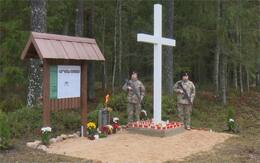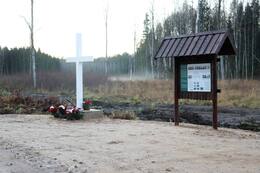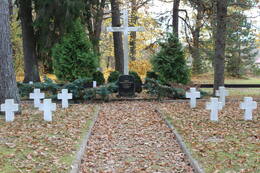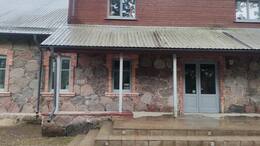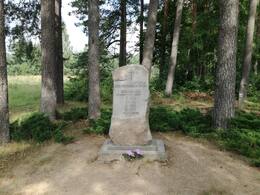Armed resistance to Soviet occupation power in Sēlia
Day 1.
48 km
Kalna parish - Aknīste - Susēja
Practical info
* Driving distance: ~48 km. Most of the roads are paved, but access to more remote sites may be via gravel roads.
* There are very few places to eat lunch and dinner along the route. You can order a meal in advance or bring your own food for lunch.
* The former Susēja parish house can be visited by prior appointment. SUSēJA operates as an art residence, where the “Sanssouci” festival is held once a year.
* Memorials can be viewed at any time
* LIEPAS only offers banquet service and accommodation, it does not operate as a daily café.
* The itinerary is intended as a guide - how to optimally travel around a region or country with the aim of getting to know its military heritage;
* The traveler plans how many of the recommended objects and places he can explore in one day;
* Before traveling, you should check the opening hours of sightseeing places (museums, collections, fortifications, etc.);
* For places where advance booking is required (local guides, private collections, etc.), a visit must be booked, specifying the date and time. If the trip is cancelled, the places booked must be informed;
* Accommodation must be booked in advance. Accommodation may be unavailable during the summer season, especially on the coast. Some catering establishments may not be open during the winter season;
* Choose not only summer for your trip, but also other seasons;
* Visit tourist information centers where you can get additional information, brochures, and maps.
Sights
Memorial site to the members of the P. Prauliņš national partisan group and the site of the bunker
Pēteris Prauliņš (1911-1949) Birži parish national partisan group was part of the group led by Mārtiņš Pokļevinskis (1902-1951). The group carried out several partisan actions, in which Soviet collaborators were punished and food and property of the economic institutions of the occupation authorities were requisitioned. P. Prauliņš's group partisans did not observe sufficient conspiracy, many persons visited their settlement, which created an opportunity for betrayal. The lack of military experience was one of the shortcomings of the partisan armed movement.
P. Prauliņš's partisan group in the Kalna forest in the Birži parish was destroyed on May 16, 1949, during an operation by the Ministry of State Security of the Latvian SSR, in which military units also participated. The forest brothers had set up a bunker with perimeter defense, which was well camouflaged and was located at an undetermined height in a swampy area. The partisans fiercely resisted the Cheka troops for at least 40 minutes, but the entire group fell: Pēteris Prauliņš, Artūrs Bružuks, Jānis Kalvāns, Edvīns Slikšāns and Francis Skromanis. The shot forest brothers were thrown near the parish house, but their remains were later buried in nearby gravel pits. Irma Bružuka was seriously wounded, who was captured and died on May 17 in Jēkabpils Hospital. She was buried outside the cemetery, but when the cemetery was expanded after Latvia regained its independence, a monument was placed on her grave.
A memorial stone to the partisans of P. Prauliņš' group in Kalna parish was consecrated in November 1998. The site of P. Prauliņš' bunker is located in section 4 of Vidsala 99th block, Kalna parish. The stone on which P. Prauliņš sat has been preserved.
Memorial site to the members of the J. Indāns - J. Grāvelsons and M. Pokļevinskis national partisan groups
An information stand and memorial site for the Indāns - Grāvelsons national partisan group in Kalna parish, Jēkabpils region, in the vicinity of Sūpes purvas, was opened on Lāčplēsis Day - November 11, 2019. Representatives of Jēkabpils region and Viesīte region, former national partisan H. Miezīte, historian H. Bruņinieks, as well as guests from Lithuania and other interested parties participated in its opening. The memorial site and stand are located near Sūpes purvas, which is associated with the sites of national partisan settlements and battles. Deeper in the forest was also the bunker of the Indāns-Grāvelsons group.
After the deportations of the Latvian population on March 25, 1949, the national partisan supply system was destroyed. From the summer of 1949 to mid-1952, the national partisan movement in the Aknīste, Sauka, Elkšņi, Birži and Viesīte areas experienced its decline, as it suffered from ethnic cleansing and regular counterattacks by the Soviet army and security institutions. The settlement of the national partisan group of Jānis Indāns and Jānis Grāvelsons in the Elkšņi forest in the winter of 1949-1950 had a very serious defense system, uncharacteristic for that time, which did not exist anywhere else in Latvia or in its neighboring country Lithuania in the 1950s. The bunker of the Indāns-Grāvelsons group had specially created perimeter defense trenches and gun nests. Along with the partisans' military readiness to sacrifice their lives in the fight against the enemy, it is also possible to speak of their special identity, which was also manifested in the involvement of other family members in the ranks of the national partisans.
The Indāns-Grāvelsons joint partisan group consisted of 12 people, including five women and one Lithuanian partisan: Jānis Indāns, Jānis Edvards Grāvelsons, Alma Grāvelsone, Pēteris Indāns, Kristīne Indāne, Milda Ārija Indāne, Vasilijs Sokolovs, Voldemārs Otto Sātnieks, Jānis Ķepiņš, Hilda Vietniece, Artūrs Snikus, Jons Žukauskis. Their last battle took place on February 25, 1950, in the Elkšņu Forest, when 11 partisans fell in battle against disproportionately strong forces. Only Hilda Vietniece (Miezīte) survived, who was captured and later spent six years in prison in the Gulag camps.
Memorial site at the site of the national partisan battle of February 13, 1945 in the Diamond Forest of Kalna Parish
The memorial site was created on the regional road P74 Siliņi - Aknīste, 12 kilometers from Aknīste, turning onto the Latvian State Forest "Žagari ceļa".
The vast forest massif of the northern part of Elkšķi parish already at the end of the summer of 1944 became a gathering place for people who were preparing for armed struggle against the Soviet occupation power. At the end of 1944, national partisan groups began to form in the Aknīste area. A suitable place for establishing a partisan camp was the Diamond Forest , which was located on the southern edge of the Elkšķi large forest, near the Aknīste Great Swamp. There, less than 10 kilometers from Aknīste parish, the national partisans created three winter bunkers for wintering. Communications of the men gathered in the forest were ensured with the support of nearby houses - Baltimores, Gargrodes, Līči, Priedes, Krūmi and residents of other houses, neighbors and partisans.
The partisan battle with the soldiers of the Latvian SSR Ministry of State Security in the Diamond Forest took place on February 13, 1945. The Chekists, having taken hostages, drove them forward to reveal the partisan bunkers. The Forest Brothers, seeing the danger, opened fire, not sparing the hostages. 10 representatives of the Soviet occupation troops, eight national partisans and four hostages fell in the battle. Despite the losses of the Forest Brothers, the Chekists failed to capture the partisan bunkers. The surviving partisans waited for darkness and left the settlement. The Chekist soldiers wounded in the battle, groaning, were unable to leave the battlefield. After this battle, which can be considered the forest brothers' first "baptism of battle", the partisans felt like brothers and the rifle seemed more precious than anything, like the only reliable savior.
The White Cross and information stand in the Diamond Forest were installed on Lāčplēsis Day - November 11, 2022. The creation of the memorial site was supported by the Jēkabpils regional government, the association "Tēvzemes sargi" and the Latvian State Forests. The author of the content of the information stand is historian Haralds Bruņinieks.
Cemeteries of the National Partisans of Sēlia
The Sēlija National Partisan Brothers Cemetery was opened on October 30, 2004 with the support of the Latvian Ministry of Defence and the Aknīste Municipality. The partisans who fell in the battle of December 19, 1949 in the Dimantu Forest of Kalna Parish are buried there: Alberts Karankevičs (1914-1949), Vilis Tunķels (1911-1949), Arnolds Tunķels (1926-1949), Osvalds Tunķels (1929-1949), Ēvalds Kundzāns (1927-1949).
In 2005, the partisans who fell in the battle of February 13, 1945 in the Elkšņi Forest were also reburied here: Juris Alfreds Voldemārs Lācis (1908-1945), Eduards Kaminskis (1910-1945), Osvalds Mežaraups (1911-1945), Alberts Mežaraups (1915-1945), Antons Bružiks (1911-1945), Jānis Britāns (1926-1945) and one unknown. The common cemetery also contains the remains of Marta Mežaraupe (1907-1945), Alberts Lācis (1902-1945), Juris Resnītis (1901-1945) and Pēteris Bite (1907-1945), who were taken hostage by the Soviet occupation authorities and fell during the battle, as well as Voldemārs Otto Sātnieks (1911-1950), a fallen partisan of the Indāns-Grāvelsons group. The Aknīste Brothers' Cemetery also houses a monument to Alfreds Silaraup (1925-1946), a national partisan of the Aknīste Company, who fell during a Cheka operation on July 30, 1946, on the narrow-gauge railway in the Elkšņu Forest.
At the foot of the White Cross erected at the Brothers' Cemetery of the National Partisans of Sēlija, a black granite stele with the emblem of the Latvian National Partisan Association and the text engraved below it, "To the National Partisans of Sēlija. You sacrificed your lives for Latvia in the fight against the communist occupation regime in 1944-1954." There is also a memorial stone in the cemetery with the inscription "There are tears that will be shed in silence. There are scars that will not heal when healed," which was erected by Stanislava Šadurska at the beginning of the Awakening near the pit where the Chekists buried the national partisans and hostages who had fallen the day before on February 14, 1955.
Former Susēja parish house, site of attack by national partisans on July 7, 1945
Today, the former Susėja parish house houses the Sanssouci residence center. The facade of the building still bears traces of the attack left by bullets fired by national partisans during the attack on July 7, 1945.
The former Susēja parish house, which at that time functioned as the local executive committee of the Soviet occupation authorities, suffered an attack by the Sēlija national partisans on July 7, 1945. The attack on the Susēja executive committee was part of a wider national partisan campaign and took place simultaneously with the attacks on the Vilkupe butter factory and the house of the destroyer Kaunackas.
According to the instructions of the commander of the Susėja national partisan group, Albert Kaminskis (1920-1946), the Forest Brothers were to destroy the security of the local executive committee, take weapons, militia uniforms, documents and damage telephone communications. About 17 Forest Brothers under the leadership of the Lithuanian partisan commander Jozas Kuveikis participated in the attack on the Susėja executive committee. The battle lasted 15-20 minutes, one Lithuanian partisan fell during the firefight, and on the other side - a fighter of the destroyer battalion Jānis Kakarāns. During the firefight, the windows of the executive committee were broken and the telephone was damaged.
The second attack on the Susēja Executive Committee took place on July 16, 1945, when a prolonged firefight took place between the Forest Brothers and fighters of the destroyer battalion who had sought refuge in the Executive Committee building. During the battle, a group of Soviet soldiers came to the aid of the latter, who opened machine-gun fire from the flank and forced the partisans to retreat. At least five Forest Brothers and five destroyers fell in the battle. The attacks on this administrative object of the occupation power confirmed the nature of the armed resistance of the partisan war and were a warning about the people's resistance to the Soviet occupation power.
Monument to the National Partisans of Susėja
The Susēja national partisan unit was formed from smaller fragmented forest brotherhood groups, because initially there was no leader who could unite them. For a short time, Artūrs Grābeklis tried to coordinate the activities of the Susēja partisans, and later Markejs Gorovņovs, who fell in the winter of 1945. The Susēja national partisan unit was strengthened after the former legionnaire Alberts Kaminskis arrived in Courland, Sēlija, after the general capitulation of Germany. He established stricter discipline and united smaller groups for a joint fight against the Soviet occupation power. Cooperation was also established with forest brotherhood groups from nearby parishes and areas, especially with the Gārsene group and Lithuanian partisans who had settled on the border of Lithuania and Latvia.
In the early stages of the armed movement, it is clear that the Forest Brothers were not prepared for attacks, unable to occupy either the Kaunacki farmstead or break into the building of the Susėja executive committee. The partisans suffered losses and were unable to resist the Cheka troops for a long time, and the main method of fighting was to think about retreating in time. There was also a problem with the supply of the partisans. Despite the existing difficulties, the Susėja national partisan unit was still able to actively resist the Soviet occupation power in the first post-war years. This partisan group ceased to exist after the fall of its commander A. Kaminskis on May 14, 1946. This was also followed by the legalization of several Forest Brothers, as well as joining other partisan groups.
The monument to the national partisans of the Susēja company was opened on November 11, 1997, at the initiative of Gunārs Blūzmas, a researcher of the history of the national partisans of Sēlija. Next to the names of the fallen Susēja national partisans, a text is carved into a roughly worked boulder under the sign of a cross: “On the head of a hedgehog, I ordered you to protect your father’s land.” The monument mentions those who fell in the attack on the Susēja executive committee on July 16, 1945 - Jānis Grābeklis (1923-1945), Ādolfs Rācenis (1919-1945), Broņislavs-Arvīds Bīriņš (1919-1945) and Edgars Ērglis (1920-1945), and later the names of the murdered Līna Kaminska (1917-1945) and Albert Kaminskas (1920-1946) were added. The monument is missing the names of Arnolds Dombrovskis (1923-1945) and other national partisans who were active in the Susēja national partisan groups and who fell in 1945-1946.
**************************************************************
The Rural Traveler's tourism route through Sēlija offers a detailed summary with additional places of interest :
https://site-244605.mozfiles.com/files/244605/ Selija-LAT-3.pdf
Places to eat
Kafeja Alīda
Aromatic coffee is produced here from chicory and on the basis of ancient recipes from grandma Alīda. All of the ingredients come from surrounding fields and forests. Roasted chicory coffee PAULĪNE (rye, chicory, carrots, acorns); roasted rye, chicory, and hemp coffee SĒLIJA (rye, chicory, carrots, hemp leaves); rye malt, chicory, and hop coffee VIESĪTE (rye malt grains, chicory, hops). Produce can be purchased.The owner will offer you a tour, during which you will be able to taste and buy her coffee.
Cafe "Kalniņa" offers high-quality meals, snacks, various drinks and cocktails.
Both a bistro-style buffet and pre-combined portions are available.
Group catering is also provided upon prior arrangement.
https://visit.jekabpils.lv/lv/objekti/paliec/edinasana/vieta/kafejnica-kalnina-akniste/
https://www.facebook.com/kafejnicakalnina
Places to stay
LIEPAS
Guest house Liepas offers four rooms - two comfort (with WC, shower, TV), two with shared WC and shower. There is a spacious balcony, lobby with seating area, TV, Novus table, 24/7 Tea table. Catering in the ground floor cafe. Please arrange breakfast and dinner at the time of booking.
The Gārsene Castle Hostel offers accommodation in both beds and mattresses, and the capacity of the rooms also varies greatly - double, quadruple, six-person, etc.
In total, the castle can accommodate 45 guests in beds and 37 guests on mattresses at a time.
All guests have access to shared showers, toilets and a kitchenette. It is possible to stay overnight in tents in the castle park.
http://www.garsenespils.lv/naksnosana/
***
The recreation complex "Kalniņa" offers a wide range of hospitality services: a hotel, a cafe, a modern SPA complex and a gym. There is also a large outdoor recreation area with a pond of almost a hectare, located in a picturesque area surrounded by hills.
The hotel has seven bedrooms and a total of 32 beds.
https://visit.jekabpils.lv/lv/objekti/paliec/naktsmitnes/vieta/atputas-komplekss-kalnina-/





